According to the observations at 17:30 hrs MST today, monsoon is strong to vigorous over the Andaman Sea and Bay of Bengal, due to the easterly waves and westerly waves, rain or thundershowers are likely to be fairly widespread to widespread in Naypyitaw, Yangon, Mandalay, Bago, Magway, Sagaing, Ayeyarwady, Taninthayi Regions and Kachin, Kayah, Kayin, Chin, Mon, Rakhine, Shan States with likelihood of regionally and isolated heavyfalls during tonight to 28-6-2025. Occassional squalls with rough seas will be experienced off and along Myanmar Coasts.
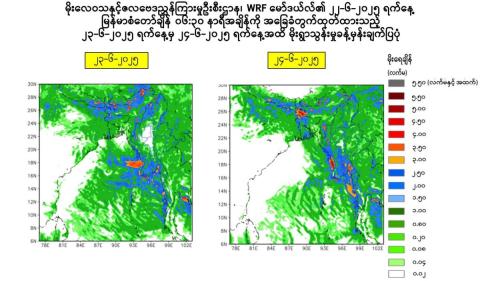
According to the observations at 17:30 hrs MST today, monsoon is strong to vigorous over the Andaman Sea and Bay of Bengal, due to the easterly waves and westerly waves, rain or thundershowers are likely to be fairly widespread to widespread in Naypyitaw, Yangon, Mandalay, Bago, Magway, Sagaing, Ayeyarwady, Taninthayi Regions and Kachin, Kayah, Kayin, Chin, Mon, Rakhine, Shan States with likelihood of regionally and isolated heavyfalls during tonight to 28-6-2025. Occassional squalls with rough seas will be experienced off and along Myanmar Coasts. Surface wind speed in squalls may reach 35 mph. Wave height will be about 11-13 feet off and along Myanmar Coasts.
Advisory
People should be awared the natural disasters such as the heavy rainfall with strong wind, thunder, Lightning strike, lightning, hails, flash flood and landslide in the hilly areas and near small rivers and to make necessary preparations for inland water transport, domestic flight and irrigation dams.
DMH
According to the observations at 17:30 hrs MST today, monsoon is strong to vigorous over the Andaman Sea and Bay of Bengal, due to the easterly waves and westerly waves, rain or thundershowers are likely to be fairly widespread to widespread in Naypyitaw, Yangon, Mandalay, Bago, Magway, Sagaing, Ayeyarwady, Taninthayi Regions and Kachin, Kayah, Kayin, Chin, Mon, Rakhine, Shan States with likelihood of regionally and isolated heavyfalls during tonight to 28-6-2025. Occassional squalls with rough seas will be experienced off and along Myanmar Coasts. Surface wind speed in squalls may reach 35 mph. Wave height will be about 11-13 feet off and along Myanmar Coasts.
Advisory
People should be awared the natural disasters such as the heavy rainfall with strong wind, thunder, Lightning strike, lightning, hails, flash flood and landslide in the hilly areas and near small rivers and to make necessary preparations for inland water transport, domestic flight and irrigation dams.
DMH

Chairman of the State Administration Council Prime Minister Senior General Min Aung Hlaing made inspection at the factories and workshops in Yangon Region on Saturday.
The Prime Minister and party visited Solar Panel Factory of Shwe Katha Company Limited, being operated at the Electronics and Electric Motor Workshop of No.2 Heavy Industries. He heard reports on work undertakings and production f solar panels at the factory.
Chairman of the State Administration Council Prime Minister Senior General Min Aung Hlaing made inspection at the factories and workshops in Yangon Region on Saturday.
The Prime Minister and party visited Solar Panel Factory of Shwe Katha Company Limited, being operated at the Electronics and Electric Motor Workshop of No.2 Heavy Industries. He heard reports on work undertakings and production f solar panels at the factory.
In response to the report, the Prime Minister stressed to produce import standard solar panels while catching up the improving technologies. He also urged the ministry to strive for generating solar-powered electricity from household use to commercial use. Since it will be beneficial to the country, he called for sufficient production of solar panels through joint efforts between the Ministry of Electric Power and the Ministry of Industry.
The Prime Minister and party later viewed the production process of solar panels. They then proceeded to the Tyre Factory (Ywama) under the Myanmar Economic Corporation and heard reports on production of tyres and inner tube. He also instructed for producing quality products for meeting the local demand and exporting to international market. They then arrived at the No.3 Steel Mill (Ywama), and heard reports on work processes.
The Prime Minister instructed to encourage the production of steel locally, ensuring the quality products. They then viewed the production process of HRB-500 Steel Billets.
On arrival at the No.2 Steel Mill (Myaungdagar) in Hmawby Township, the Prime Minister heard reports on work undertakings and instructed for boosting production to meet the local demand while upgrading the facilities. They then viewed the production process of the mill.
During the visit, the Prime Minister inspected the site of Jetty and gave instructions upon the reports by the officials.
mitv
Chairman of the State Administration Council Prime Minister Senior General Min Aung Hlaing made inspection at the factories and workshops in Yangon Region on Saturday.
The Prime Minister and party visited Solar Panel Factory of Shwe Katha Company Limited, being operated at the Electronics and Electric Motor Workshop of No.2 Heavy Industries. He heard reports on work undertakings and production f solar panels at the factory.
In response to the report, the Prime Minister stressed to produce import standard solar panels while catching up the improving technologies. He also urged the ministry to strive for generating solar-powered electricity from household use to commercial use. Since it will be beneficial to the country, he called for sufficient production of solar panels through joint efforts between the Ministry of Electric Power and the Ministry of Industry.
The Prime Minister and party later viewed the production process of solar panels. They then proceeded to the Tyre Factory (Ywama) under the Myanmar Economic Corporation and heard reports on production of tyres and inner tube. He also instructed for producing quality products for meeting the local demand and exporting to international market. They then arrived at the No.3 Steel Mill (Ywama), and heard reports on work processes.
The Prime Minister instructed to encourage the production of steel locally, ensuring the quality products. They then viewed the production process of HRB-500 Steel Billets.
On arrival at the No.2 Steel Mill (Myaungdagar) in Hmawby Township, the Prime Minister heard reports on work undertakings and instructed for boosting production to meet the local demand while upgrading the facilities. They then viewed the production process of the mill.
During the visit, the Prime Minister inspected the site of Jetty and gave instructions upon the reports by the officials.
mitv
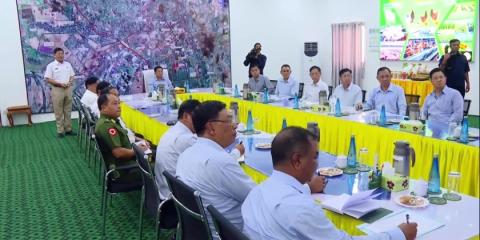
Chairman of the State Administration Council Prime Minister Senior General Min Aung Hlaing visited Shwe Pyi Agriculture and Livestock Breeding Zone under the Myanmar Economic Corporation in Hmawby Township of Yangon Region on Saturday.
In the briefing hall, officials provided update reports on work implementations, breeding of poultry and pig, cultivation of maize and construction of animal feed factory. The Prime Minister instructed for systematic sales of the produces and boosting production to meet the demand of consumers.
Chairman of the State Administration Council Prime Minister Senior General Min Aung Hlaing visited Shwe Pyi Agriculture and Livestock Breeding Zone under the Myanmar Economic Corporation in Hmawby Township of Yangon Region on Saturday.
In the briefing hall, officials provided update reports on work implementations, breeding of poultry and pig, cultivation of maize and construction of animal feed factory. The Prime Minister instructed for systematic sales of the produces and boosting production to meet the demand of consumers.
The Prime Minister and party later viewed the scale model of the Agriculture and Livestock Breeding Zone as well as the breeding of pig and poultry.
mitv
Chairman of the State Administration Council Prime Minister Senior General Min Aung Hlaing visited Shwe Pyi Agriculture and Livestock Breeding Zone under the Myanmar Economic Corporation in Hmawby Township of Yangon Region on Saturday.
In the briefing hall, officials provided update reports on work implementations, breeding of poultry and pig, cultivation of maize and construction of animal feed factory. The Prime Minister instructed for systematic sales of the produces and boosting production to meet the demand of consumers.
The Prime Minister and party later viewed the scale model of the Agriculture and Livestock Breeding Zone as well as the breeding of pig and poultry.
mitv
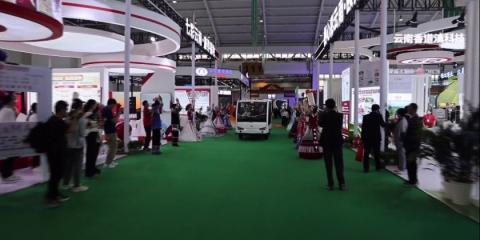
A Myanmar delegation led by State Administration Council member, Deputy Prime Minister, and Union Minister at the Prime Minister’s Office General Tin Aung San attended the 9th China-South Asia Expo and the 29th Kunming Import and Export Fair in Kunming, from June 17 to 20 at the invitation of the Yunnan Provincial Government.
Upon arrival in Kunming on June 17, the delegation was welcomed by the Deputy Chairman of the Standing Committee of the Yunnan People’s Congress, and the Myanmar Consul-General in Kunming.
A Myanmar delegation led by State Administration Council member, Deputy Prime Minister, and Union Minister at the Prime Minister’s Office General Tin Aung San attended the 9th China-South Asia Expo and the 29th Kunming Import and Export Fair in Kunming, from June 17 to 20 at the invitation of the Yunnan Provincial Government.
Upon arrival in Kunming on June 17, the delegation was welcomed by the Deputy Chairman of the Standing Committee of the Yunnan People’s Congress, and the Myanmar Consul-General in Kunming.
On the 19th, the delegation attended the opening ceremony of the expo, where General Tin Aung San delivered a speech alongside other dignitaries from China, Afghanistan, Maldives, Laos, and Vietnam. General Tin Aung San also met with Mr. Wang Dongming, Vice Chairman of China’s National People’s Congress Standing Committee, to discuss cooperation in energy, agriculture, and ongoing Chinese projects in Myanmar.
The Myanmar delegation later visited Myanmar Pavilion and encouraged local businesses to take advantage of the platform to expand exports.
On the 18th, the delegation met with several Chinese companies including Union Resources & Engineering Co., Ltd, Yunnan Energy Investment Group, and State Power Investment Yunnan International Co., Ltd. to discuss investment in Myanmar’s energy sector.
The delegation also held talks with Mr. Wang Ning, Secretary of the Yunnan Provincial Committee of the Chinese Communist Party, focusing on future collaboration in agriculture and energy. That evening, they attended a dinner hosted in their honor.
The delegation departed Kunming on June 20 and was welcomed back in Yangon by the Yangon Region Chief Minister, military officials, and the Chinese Embassy’s Political Counselor. More than 4,800 booths from 53 countries including China, South Asia, Southeast Asia, and others participated in the expo.
mitv
A Myanmar delegation led by State Administration Council member, Deputy Prime Minister, and Union Minister at the Prime Minister’s Office General Tin Aung San attended the 9th China-South Asia Expo and the 29th Kunming Import and Export Fair in Kunming, from June 17 to 20 at the invitation of the Yunnan Provincial Government.
Upon arrival in Kunming on June 17, the delegation was welcomed by the Deputy Chairman of the Standing Committee of the Yunnan People’s Congress, and the Myanmar Consul-General in Kunming.
On the 19th, the delegation attended the opening ceremony of the expo, where General Tin Aung San delivered a speech alongside other dignitaries from China, Afghanistan, Maldives, Laos, and Vietnam. General Tin Aung San also met with Mr. Wang Dongming, Vice Chairman of China’s National People’s Congress Standing Committee, to discuss cooperation in energy, agriculture, and ongoing Chinese projects in Myanmar.
The Myanmar delegation later visited Myanmar Pavilion and encouraged local businesses to take advantage of the platform to expand exports.
On the 18th, the delegation met with several Chinese companies including Union Resources & Engineering Co., Ltd, Yunnan Energy Investment Group, and State Power Investment Yunnan International Co., Ltd. to discuss investment in Myanmar’s energy sector.
The delegation also held talks with Mr. Wang Ning, Secretary of the Yunnan Provincial Committee of the Chinese Communist Party, focusing on future collaboration in agriculture and energy. That evening, they attended a dinner hosted in their honor.
The delegation departed Kunming on June 20 and was welcomed back in Yangon by the Yangon Region Chief Minister, military officials, and the Chinese Embassy’s Political Counselor. More than 4,800 booths from 53 countries including China, South Asia, Southeast Asia, and others participated in the expo.
mitv
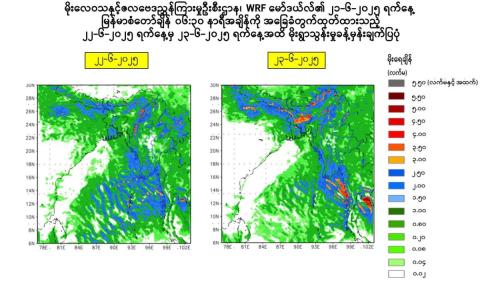
According to the observations at 17:30 hrs MST today, monsoon is strong over the Andaman Sea and Bay of Bengal, due to the easterly waves and westerly waves, rain or thundershowers are likely to be fairly widespread to widespread in Naypyitaw, Yangon, Mandalay, Bago, Magway, Sagaing, Ayeyarwady, Taninthayi Regions and Kachin, Kayah, Kayin, Chin, Mon, Rakhine, Shan States with likelihood of regionally and isolated heavyfalls during tonight to 25-6-2025. Squalls with rough seas are likely at times off and along Myanmar Coasts. Surface wind speed in squalls may reach 30 mph.
According to the observations at 17:30 hrs MST today, monsoon is strong over the Andaman Sea and Bay of Bengal, due to the easterly waves and westerly waves, rain or thundershowers are likely to be fairly widespread to widespread in Naypyitaw, Yangon, Mandalay, Bago, Magway, Sagaing, Ayeyarwady, Taninthayi Regions and Kachin, Kayah, Kayin, Chin, Mon, Rakhine, Shan States with likelihood of regionally and isolated heavyfalls during tonight to 25-6-2025. Squalls with rough seas are likely at times off and along Myanmar Coasts. Surface wind speed in squalls may reach 30 mph. Wave height will be about 10-12 feet off and along Myanmar Coasts.
Advisory
People should be awared the natural disasters such as the heavy rainfall with strong wind, thunder, Lightning strike, lightning, hails, flash flood and landslide in the hilly areas and near small rivers and to make necessary preparations for inland water transport, domestic flight and irrigation dams.
DMH
According to the observations at 17:30 hrs MST today, monsoon is strong over the Andaman Sea and Bay of Bengal, due to the easterly waves and westerly waves, rain or thundershowers are likely to be fairly widespread to widespread in Naypyitaw, Yangon, Mandalay, Bago, Magway, Sagaing, Ayeyarwady, Taninthayi Regions and Kachin, Kayah, Kayin, Chin, Mon, Rakhine, Shan States with likelihood of regionally and isolated heavyfalls during tonight to 25-6-2025. Squalls with rough seas are likely at times off and along Myanmar Coasts. Surface wind speed in squalls may reach 30 mph. Wave height will be about 10-12 feet off and along Myanmar Coasts.
Advisory
People should be awared the natural disasters such as the heavy rainfall with strong wind, thunder, Lightning strike, lightning, hails, flash flood and landslide in the hilly areas and near small rivers and to make necessary preparations for inland water transport, domestic flight and irrigation dams.
DMH
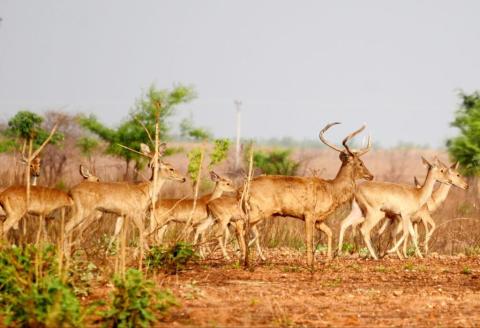
At the Mann Shwesettaw Wildlife Sanctuary, 60 golden deer, native and rare species, have been conserved, according to U Aye Ko, Mann Shwesettaw’s trustee board chair.
Formerly, the sanctuary began with five male deer and seven female deer and new fawns were born again about four months ago. “There were 52 deer formerly, and now new fawns increase — four males and four females, and they are already listed in,” he said.
At the Mann Shwesettaw Wildlife Sanctuary, 60 golden deer, native and rare species, have been conserved, according to U Aye Ko, Mann Shwesettaw’s trustee board chair.
Formerly, the sanctuary began with five male deer and seven female deer and new fawns were born again about four months ago. “There were 52 deer formerly, and now new fawns increase — four males and four females, and they are already listed in,” he said.
The sanctuary feeds them watercress, water hyacinth and supplements and visitors are invited to watch deer. A golden deer camp was initially planned to be set up, though it has been delayed for some reason. — Htet Oo Maung/ZS
At the Mann Shwesettaw Wildlife Sanctuary, 60 golden deer, native and rare species, have been conserved, according to U Aye Ko, Mann Shwesettaw’s trustee board chair.
Formerly, the sanctuary began with five male deer and seven female deer and new fawns were born again about four months ago. “There were 52 deer formerly, and now new fawns increase — four males and four females, and they are already listed in,” he said.
The sanctuary feeds them watercress, water hyacinth and supplements and visitors are invited to watch deer. A golden deer camp was initially planned to be set up, though it has been delayed for some reason. — Htet Oo Maung/ZS
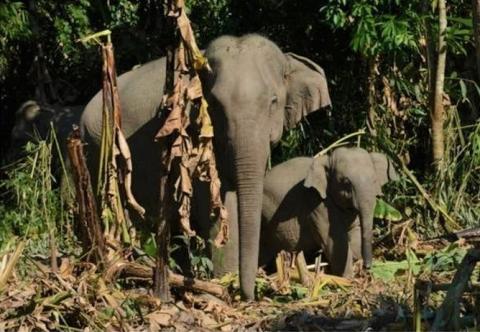
There are two different types of elephants: the African elephant and the Asian elephant. The Taninthayi Nature Reserve in Myanmar is estimated to have between 45-64 Asian elephants.
In 2011, in the Taninthayi Nature Reserve, such elephants were found to inhabit 90 per cent of the reserve, and it is estimated that their population may have increased since now.
There are two different types of elephants: the African elephant and the Asian elephant. The Taninthayi Nature Reserve in Myanmar is estimated to have between 45-64 Asian elephants.
In 2011, in the Taninthayi Nature Reserve, such elephants were found to inhabit 90 per cent of the reserve, and it is estimated that their population may have increased since now.
Read more: https://www.gnlm.com.mm/over-64-asian-elephants-spotted-in-taninthayi-nature-reserve/#article-title
There are two different types of elephants: the African elephant and the Asian elephant. The Taninthayi Nature Reserve in Myanmar is estimated to have between 45-64 Asian elephants.
In 2011, in the Taninthayi Nature Reserve, such elephants were found to inhabit 90 per cent of the reserve, and it is estimated that their population may have increased since now.
Read more: https://www.gnlm.com.mm/over-64-asian-elephants-spotted-in-taninthayi-nature-reserve/#article-title
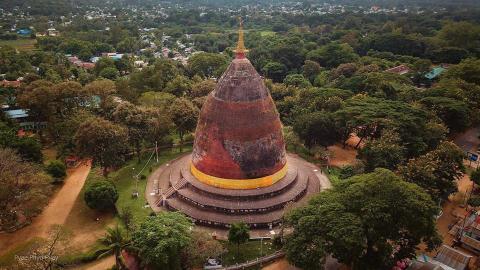
Religious buildings in the Sri Ksetra Cultural Zone, a World Heritage Site in Pyay Township, Bago Region, will be renovated while preserving their original features, according to U Tun Tun Aye, head of the Department of Archaeology and National Museum (Sri Ksetra Branch).
Cracks appeared in the Bawbawgyi Pagoda and the Lemyethna Pagoda within the zone due to the Mandalay earthquake on 28 March, and the damaged areas will reportedly be repaired without compromising the original structures.
Religious buildings in the Sri Ksetra Cultural Zone, a World Heritage Site in Pyay Township, Bago Region, will be renovated while preserving their original features, according to U Tun Tun Aye, head of the Department of Archaeology and National Museum (Sri Ksetra Branch).
Cracks appeared in the Bawbawgyi Pagoda and the Lemyethna Pagoda within the zone due to the Mandalay earthquake on 28 March, and the damaged areas will reportedly be repaired without compromising the original structures.
“When the Mandalay earthquake struck, the Sri Ksetra Cultural Zone was also affected. Most of the pagodas here were not very tall and therefore did not sustain serious damage. However, the slightly taller Bawbawgyi Pagoda and the Lemyethna Temple were damaged, as their structures were already weakened. Since they have been damaged, we must take the time to restore them while preserving their originality,” said U Tun Tun Aye.
The Bawbawgyi Pagoda is one of the oldest structures in the ancient Pyu city of Sri Ksetra, while the Lemyethna Temple is another notable example of Pyu architecture. Built around the 6th–7th century AD, the Bawbawgyi Pagoda stands 46.634 metres high and has a circumference of 64.8 metres. Its design features a five-tiered platform topped by a long, cylindrical brick structure. The pagoda is said to resemble the Dhamek Stupa in Sarnath, India, a memorial site where the Buddha delivered the Anattalakkhana Sutta, also known as the Discourse on the Characteristic of Non-self.
Similarly, the Lemyethna Temple is the only cave pagoda found in the ancient city of Sri Ksetra. This small, square structure features four arches and entrances and is estimated to have been built during the late Pyu period, between the 7th and 9th centuries. The Lemyethna Temple is a significant monument that illustrates the development of cave pagodas in Pyu Buddhist architecture.
Three ancient Pyu cities in Myanmar — Beikthano, Halin, and Sri Ksetra — were designated as World Heritage Sites in June 2014. — ASH/TH
Source: The Global New Light of Myanmar
Religious buildings in the Sri Ksetra Cultural Zone, a World Heritage Site in Pyay Township, Bago Region, will be renovated while preserving their original features, according to U Tun Tun Aye, head of the Department of Archaeology and National Museum (Sri Ksetra Branch).
Cracks appeared in the Bawbawgyi Pagoda and the Lemyethna Pagoda within the zone due to the Mandalay earthquake on 28 March, and the damaged areas will reportedly be repaired without compromising the original structures.
“When the Mandalay earthquake struck, the Sri Ksetra Cultural Zone was also affected. Most of the pagodas here were not very tall and therefore did not sustain serious damage. However, the slightly taller Bawbawgyi Pagoda and the Lemyethna Temple were damaged, as their structures were already weakened. Since they have been damaged, we must take the time to restore them while preserving their originality,” said U Tun Tun Aye.
The Bawbawgyi Pagoda is one of the oldest structures in the ancient Pyu city of Sri Ksetra, while the Lemyethna Temple is another notable example of Pyu architecture. Built around the 6th–7th century AD, the Bawbawgyi Pagoda stands 46.634 metres high and has a circumference of 64.8 metres. Its design features a five-tiered platform topped by a long, cylindrical brick structure. The pagoda is said to resemble the Dhamek Stupa in Sarnath, India, a memorial site where the Buddha delivered the Anattalakkhana Sutta, also known as the Discourse on the Characteristic of Non-self.
Similarly, the Lemyethna Temple is the only cave pagoda found in the ancient city of Sri Ksetra. This small, square structure features four arches and entrances and is estimated to have been built during the late Pyu period, between the 7th and 9th centuries. The Lemyethna Temple is a significant monument that illustrates the development of cave pagodas in Pyu Buddhist architecture.
Three ancient Pyu cities in Myanmar — Beikthano, Halin, and Sri Ksetra — were designated as World Heritage Sites in June 2014. — ASH/TH
Source: The Global New Light of Myanmar
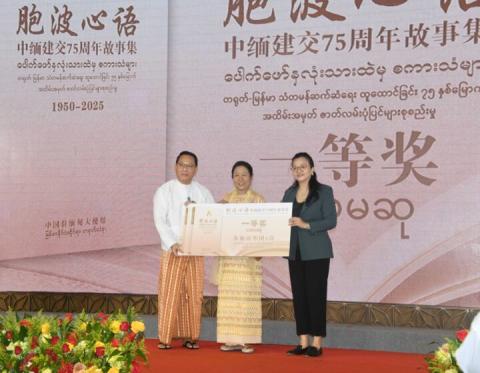
The book launch and prize awarding ceremony for “Voices from the Paukphaw Heart,” a collection of stories commemorating the 75th anniversary of Myanmar-China diplomatic relations, symbolizing the enduring Paukphaw friendship between the two nations, was held at the Wyndham Grand Yangon Hotel in Yangon yesterday.
The book launch and prize awarding ceremony for “Voices from the Paukphaw Heart,” a collection of stories commemorating the 75th anniversary of Myanmar-China diplomatic relations, symbolizing the enduring Paukphaw friendship between the two nations, was held at the Wyndham Grand Yangon Hotel in Yangon yesterday.
The event was attended by Union Minister for Information U Maung Maung Ohn, Yangon Region Chief Minister U Soe Thein and regional ministers, Chinese Ambassador to Myanmar Ms Ma Jia and embassy staff, officials from Chinese-Myanmar organizations, award winners, and invitees.
The Union Minister and guests viewed the books, records, and DVDs of the story collection commemorating the 75th anniversary of China-Myanmar diplomatic relations displayed and distributed in the hall. Then, a documentary video showcasing the mutual friendship between Myanmar and China was screened.
Ms Ma Jia, the Ambassador of the People’s Republic of China to Myanmar, said that the story collection records the deep friendship between the people of both countries and is intended for widespread distribution to the public and to be passed on to future generations.
Union Minister U Maung Maung Ohn remarked that the collection of literary works expressing the friendly exchanges between the peoples of the two countries, in honour of the 75th anniversary of Myanmar-China diplomatic relations, is a very commendable initiative. He noted that many Myanmar literary giants have translated and published Chinese classic novels and poems. He expressed hope that experts from both countries would further promote and develop exchanges in the field of Myanmar-China literary translation, and also wished for the everlasting strength and stability of Myanmar-China relations, which have been intertwined and friendly through the generations.
The Union minister and the Chinese Ambassador launched “Voices from the Paukphaw Heart,” a book published in both Myanmar and Chinese, by pressing a button.
Writer Tekkatho Mya Minzu, author of “Yangtze, Ayeyarwady Enduring Forever” for the 75th-anniversary story collection of Myanmar-China diplomatic relations, and Ms Li Lili, author of a manuscript dedicated to all volunteers proficient in both Chinese and Myanmar languages, delivered words of gratitude.
The students from Yunnan Province University and students from a school for deaf children performed a poem expressing the friendship between Myanmar and China, and a song titled “Everlasting Friendship”.
The Chinese Ambassador presented awards to the recipients of the outstanding, third, and second prizes. The Union minister and the Ambassador presented the first prize to writer Tekkatho Mya Minzu, author of “Yangtze, Ayeyawady Enduring Forever”.
The book “Voices from the Paukphaw Heart” was compiled by the Chinese Embassy in Myanmar to celebrate the 75th anniversary of Myanmar-China diplomatic relations and showcase the friendly exchanges between the people of the two countries. The embassy invited submissions on 18 March 2025 and collected essays, poems, and short stories from participants. Prizes awarded included one first prize, three-second prizes, two third prizes, and other awards.
The book is divided into five chapters: Mutual Assistance, Unforgettable Golden Moments, Bilateral Cooperation, Literary Culture, Mutual Connection, and People-to-People Ties. It features numerous exciting and heartwarming stories of friendship between the people of the two countries, historical tales that will perpetuate the China-Myanmar Paukphaw friendship, and stories of goodwill of various organizations in China and Myanmar, in both Chinese and Myanmar languages.-MNA/KTZH
Source: The Global New Light of Myanmar
The book launch and prize awarding ceremony for “Voices from the Paukphaw Heart,” a collection of stories commemorating the 75th anniversary of Myanmar-China diplomatic relations, symbolizing the enduring Paukphaw friendship between the two nations, was held at the Wyndham Grand Yangon Hotel in Yangon yesterday.
The event was attended by Union Minister for Information U Maung Maung Ohn, Yangon Region Chief Minister U Soe Thein and regional ministers, Chinese Ambassador to Myanmar Ms Ma Jia and embassy staff, officials from Chinese-Myanmar organizations, award winners, and invitees.
The Union Minister and guests viewed the books, records, and DVDs of the story collection commemorating the 75th anniversary of China-Myanmar diplomatic relations displayed and distributed in the hall. Then, a documentary video showcasing the mutual friendship between Myanmar and China was screened.
Ms Ma Jia, the Ambassador of the People’s Republic of China to Myanmar, said that the story collection records the deep friendship between the people of both countries and is intended for widespread distribution to the public and to be passed on to future generations.
Union Minister U Maung Maung Ohn remarked that the collection of literary works expressing the friendly exchanges between the peoples of the two countries, in honour of the 75th anniversary of Myanmar-China diplomatic relations, is a very commendable initiative. He noted that many Myanmar literary giants have translated and published Chinese classic novels and poems. He expressed hope that experts from both countries would further promote and develop exchanges in the field of Myanmar-China literary translation, and also wished for the everlasting strength and stability of Myanmar-China relations, which have been intertwined and friendly through the generations.
The Union minister and the Chinese Ambassador launched “Voices from the Paukphaw Heart,” a book published in both Myanmar and Chinese, by pressing a button.
Writer Tekkatho Mya Minzu, author of “Yangtze, Ayeyarwady Enduring Forever” for the 75th-anniversary story collection of Myanmar-China diplomatic relations, and Ms Li Lili, author of a manuscript dedicated to all volunteers proficient in both Chinese and Myanmar languages, delivered words of gratitude.
The students from Yunnan Province University and students from a school for deaf children performed a poem expressing the friendship between Myanmar and China, and a song titled “Everlasting Friendship”.
The Chinese Ambassador presented awards to the recipients of the outstanding, third, and second prizes. The Union minister and the Ambassador presented the first prize to writer Tekkatho Mya Minzu, author of “Yangtze, Ayeyawady Enduring Forever”.
The book “Voices from the Paukphaw Heart” was compiled by the Chinese Embassy in Myanmar to celebrate the 75th anniversary of Myanmar-China diplomatic relations and showcase the friendly exchanges between the people of the two countries. The embassy invited submissions on 18 March 2025 and collected essays, poems, and short stories from participants. Prizes awarded included one first prize, three-second prizes, two third prizes, and other awards.
The book is divided into five chapters: Mutual Assistance, Unforgettable Golden Moments, Bilateral Cooperation, Literary Culture, Mutual Connection, and People-to-People Ties. It features numerous exciting and heartwarming stories of friendship between the people of the two countries, historical tales that will perpetuate the China-Myanmar Paukphaw friendship, and stories of goodwill of various organizations in China and Myanmar, in both Chinese and Myanmar languages.-MNA/KTZH
Source: The Global New Light of Myanmar
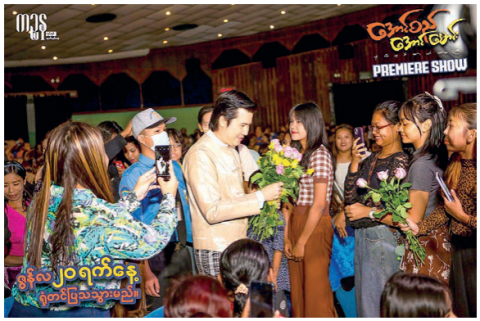
THE premiere of the Myanmar feature film ‘Aung Si Aung Maung’, which is set to be screened across cinemas nationwide on 20 June, was held in the afternoon of 17 June at the President Cinema in Dagon Township, Yangon Region.
THE premiere of the Myanmar feature film ‘Aung Si Aung Maung’, which is set to be screened across cinemas nationwide on 20 June, was held in the afternoon of 17 June at the President Cinema in Dagon Township, Yangon Region.
Speaking at the premiere, Director Khin Hlaing (Nyan Gyi Shin) said, “We filmed this movie near Tagondaing Village in Tatkon, Nay Pyi Taw. One memorable moment during the shooting was encountering flooding. We’ve done our best to make this film as good as possible. It’s a platonic love story – nothing overly dramatic. I’d just like to say: come and enjoy how the plot unfolds on the big screen.”
The screenplay of the film was adapted by K Seven from a story written by Seven Day, and the film was co-directed by Khin Hlaing (Nyan Gyi Shin) and Moe Moe under Kinsana Film Production.
The cast includes Academy Award winners Nay Toe and Tekkatho Gon Pon, along with Phyo Ngwe Soe, Tyron, Phyo Lay, Khin Hlaing, Min Hein, Naw Phaw Elhtar, Nay Chi Shunlet, Sin Ma, Si Si, Super Lin, and many others. — ASH/KNN
Source: The Global New Light of Myanmar
THE premiere of the Myanmar feature film ‘Aung Si Aung Maung’, which is set to be screened across cinemas nationwide on 20 June, was held in the afternoon of 17 June at the President Cinema in Dagon Township, Yangon Region.
Speaking at the premiere, Director Khin Hlaing (Nyan Gyi Shin) said, “We filmed this movie near Tagondaing Village in Tatkon, Nay Pyi Taw. One memorable moment during the shooting was encountering flooding. We’ve done our best to make this film as good as possible. It’s a platonic love story – nothing overly dramatic. I’d just like to say: come and enjoy how the plot unfolds on the big screen.”
The screenplay of the film was adapted by K Seven from a story written by Seven Day, and the film was co-directed by Khin Hlaing (Nyan Gyi Shin) and Moe Moe under Kinsana Film Production.
The cast includes Academy Award winners Nay Toe and Tekkatho Gon Pon, along with Phyo Ngwe Soe, Tyron, Phyo Lay, Khin Hlaing, Min Hein, Naw Phaw Elhtar, Nay Chi Shunlet, Sin Ma, Si Si, Super Lin, and many others. — ASH/KNN
Source: The Global New Light of Myanmar

